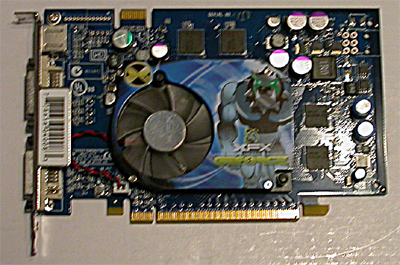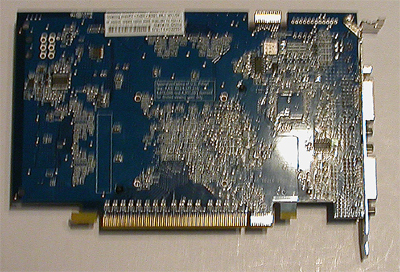XFX
This card is the beast of our roundup: The XFX 6600GT Extreme Gamer Edition. XFX is the only vendor that we've seen take a stand and do something different. The first thing to notice is the dual DVI connectors on the board. This isn't normally something one would need on a mid-range solution, but having just come from newegg.com and noticed that the standard XFX card with dual DVI costs less than some PCIe 6600 GT parts without dual DVI, there's no reason to start talking about cost being a huge issue, and thus, no good argument for why dual DVI isn't on these cards.There is something that this card has for which a premium may be charged: 1.6ns GDDR3 running at 600MHz. We haven't seen pricing yet, but this part is obviously not going to be the "be all, end all" value of graphics cards. Adding memory bandwidth is a good thing for the 6600 GT, considering the 128-bit bus. The problem is that the performance benefit is maybe half the increase in memory bandwidth, if we are lucky. And we might see better scaling with AA enabled, but on a mainstream part, that's pushing the limits.
Anyway, modifying the stock HSF, XFX placed a copper plate between the die and heatsink in order to increase the tension in the spring pegs and keep harder pressure on the GPU. Also, they are doing the same thing that we saw Leadtek do - there is a bit of material around the silicon that acts as a spacer between the rest of the GPU and the heatsink. This is necessary because the copper plate lifted the rubber nubs off the PCB making them ineffective stabilizers.

This card was loud, but cooled well due to their innovative adaptation of the stock cooling solution. The inclusion of 1.6ns GDDR3 will also be very attractive at a default clock speed of 600MHz. But this will not be appealing if it is incredibly higher priced than the current round of 6600 GT products, especially since (whether by design or chance) Sparkle's 6600 GT had 2ns RAM that overclocked to 610MHz as well.











84 Comments
View All Comments
Pete - Friday, December 10, 2004 - link
Obviously Derek OCed himself to get this article out, and he's beginning to show error. Better bump your (alarm) clocks down 10MHz (an hour) or so, Derek.pio!pio! - Friday, December 10, 2004 - link
Noticed a typo. At one point your wrote 'clock stock speed' instead of 'stock clock speed' easy mistake.Pete - Friday, December 10, 2004 - link
Another reason to narrow the distance b/w the mic and the noise source is that some of these cards may go into SFFs, or cases that sit on the desk. 12" may well be more indicative of the noise level those users would experience.Pete - Friday, December 10, 2004 - link
Great article, Derek!As usual, I keep my praise concise and my constructive criticism elaborate (although I could argue that the fact that I keep coming back is rather elaborate praise :)). I think you made the same mistake I made when discussing dB and perceived noise, confusing power with loudness. From the following two sources, I see that a 3dB increase equates to 2x more power, but is only 1.23x as loud. A 10db increase corresponds to 10x more power and a doubling of loudness. So apparently the loudest HSFs in this roundup are "merely" twice as loud as the quietest.
http://www.gcaudio.com/resources/howtos/voltagelou...
http://www.silentpcreview.com/article121-page1.htm...
Speaking of measurements, do you think 1M is a bit too far away, perhaps affording less precision than, say, 12"?
You might also consider changing the test system to a fanless PSU (Antec and others make them), with a Zalman Reserator cooling the CPU and placed at as great a distance from the mic as possible. I'd also suggest simply laying the test system out on a piece of (sound-dampening) foam, rather than fitting it in a case (with potential heat trapping and resonance). The HD should also be as quiet as possible (2.5"?).
I still think you should buy these cards yourselves, a la Consumer Reports, if you want true samples (and independence). Surely AT can afford it, and you could always resell them in FS/FT for not much of a loss.
Anyway, again, cheers for an interesting article.
redavnI - Thursday, December 9, 2004 - link
Very nice article, but any chance we could get a part 2 with any replacement cards the manufacturers send and I'd like the see the Pine card reviewed too. It's being advertised as the Anandtech Deal at the top of this article and has dual dvi like the XFX card. Kind of odd one of the only cards not reviewed gets a big fat buy me link.To me it seems that with the 6600GT/6800 series Nvidia has their best offering since the Geforce4 TI's...I'm sure I'm not the only one still hanging on to my Ti4600.
Filibuster - Thursday, December 9, 2004 - link
Something I've just realized: The Gigabyte NX66T256D is not a GT yet supports SLI. Are they using a GT that can't run at the faster speeds and selling it as a 6600 standard? It has 256MB.We ordered two from a vendor who said it definately does SLI.
http://www.giga-byte.com/VGA/Products/Products_GV-...
Can you guys find out for sure?
TrogdorJW - Thursday, December 9, 2004 - link
Derek, the "enlarged images" all seem to be missing, or else the links are somehow broken. I tested with Firefox and IE6 and neither one would resolve the image links.Other than that, *wow* - who knew HSFs could be such an issue? I'm quite surprised that they are only secured at two corners. Would it really have been that difficult to use four mount points? The long-term prospects for these cards are not looking too good.
CrystalBay - Thursday, December 9, 2004 - link
Great job on the quality control inspections of these cards D.W. Hopefully IHV's take notice and resolve these potentially damageing problems.LoneWolf15 - Thursday, December 9, 2004 - link
I didn't see a single card in this review that didn't have a really cheesey looking fan...the type that might last a couple years if you're really lucky, but might last six months on some cards if you're not. The GeForce 6600GT is a decent card; for $175-250 (depending on PCIe or AGP) you'd think vendors would put a fan deserving of the price. My PNY 6800NU came with a squirrel-cage fan and super heavy heatsink that I know will last. Hopefully, Arctic Cooling will come out with an NV Silencer soon for the 6600 family; I wouldn't trust any of the fans I saw here to last.Filibuster - Thursday, December 9, 2004 - link
What quality settings were used in the games?I am assuming that Doom 3 is in medium since these are 128MB cards.
I've read that there are some 6600GT 256MB cards coming out (Gigabyte GV-NX66T256D and MSI 6600GT-256E, maybe more) Please show us some tests with the 256MB models once they hit the streets (or if you know they are definately not, please tell us that too)
Even though the cards only have 128bit bus, wouldn't the extra ram help out in places like Doom 3 where texture quality is a matter of ram quantity? The local video ram still has to be faster than fetching it from system ram.